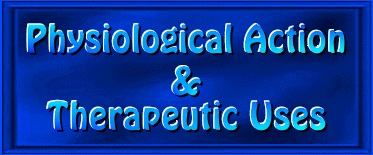

The following is excerpted from The Professional's Herbal Formula Handbook No. 2, comprising 82 pages of traditional information and recent scientific data that describes the medical properties, physiological action and therapeutic uses for each of the 24 ingredients outlined in this formula.




Adaptogenic, alterative, anabolic, anti-cachexic, anti-dyscratic, anti-infective, antioxidant, antiphlogistic (anti-inflammatory), antiseptic, astringent, bacteriostatic (anti-bacterial), biocatalyst, cell proliferant, cytophylactic, cytotoxic, decongestant, depurative, detoxicant, disinfectant, diuretic, immuno-potentiating, immuno-stimulant, microbicidal (anti-microbial), nutritive, rejuvenative, restorative, stimulant (circulatory and secretolytic) and tonic.


Alleviates any general fluids dyscrasia (abnormal or pathological condition) within the blood vessels, tissue-systems and mucous membranes throughout the entire organism during the onset of any immuno-depressant or immuno-suppressant conditions, and eliminates any form of cachexia (state of malnourishment and general debility) within the blood vessels, tissue-systems or mucous membranes throughout the entire organism in order to provide increased protection against any nutritional deficiencies or insufficiency that leads to various forms of immuno-depression or immuno-suppression; strengthens and tonifies a deficient immune system, thereby providing enhanced immunological support; exhibits immuno-potentiating and immuno-stimulatory effects in order to enhance greater long-term immune potential and overall non-specific systemic immunity (or immune cell activity) and increased immune response (by activating the body's natural defense mechanisms), particularly in relation to the repair and restoration of any damaged or congested blood vessels, tissue-systems or mucous membranes throughout the entire organism; encourages the proper elimination of toxic waste materials during the treatment of various auto-immune system disorders, and inhibits the primary absorption of various toxins while preventing their reabsorption (due to enterohepatic circulation); cleanses, stabilizes and repairs the cellular membranes of the liver while improving its functional capabilities, due to the presence of flavonoid-like compounds (flavanolignans) that are collectively referred to as "silymarin"; possesses flavanolignans (silybin, silydianin, silychristin, apigenin and silybonol) that bind themselves to the liver cell (hepatocyte) membranes in order to protect them from any injury or damage by foreign chemicals, free-radical damage, impure water intake, agricultural or industrial wastes, and endogenous or environmental toxins or pollutants, and enhances the ability of the liver cells to produce enzymes that are vital to the proper functioning of the liver by stimulating protein synthesis in order to regenerate liver tissue by producing new liver cells; accelerates the regeneration of liver tissue by enhancing the activity of certain compounds in the nucleus of the cell (specifically, by the stimulation of nuclear polymerase A activity) in order to activate the ribosomal RNA which, in turn, increases the subsequent production and synthesis of protein within the cell in order to build and nourish healthy new cells; alters the outer membranous cell structure of the liver in order to prevent certain toxic poisons from penetrating through the cellular membranes or into the interior of various cells by competing with them for the same site of occupancy, thereby inhibiting them from entering into (or overcoming) the nucleus of the cell itself; accelerates the recovery process in those conditions involving liver damage from exposure to heavy metals, radiation or various toxic chemicals, such as DDT, dioxin, PCB or PCP, alcohol, food additives, and prescription or recreational drugs; accelerates the improvement of increased serum levels of glutamic-oxalacetic transaminase (GOT), glutamic-pyruvic transaminase (GPT) or gamma glutamyl-transpeptidase (Gamma-GT), and increases the redox state and total glutathione content of the liver, stomach and intestines in order to detoxify a diverse range of hormones, psychopharmacologic drugs or toxic chemicals (including carbon tetrachloride, ethanol, galactosamine and praseodymium nitrate); counteracts any increased leukotriene synthesis or inflammation by suppressing the pathological decomposition of membrane lipids, as well as by acting as a potent inhibitor of the enzyme lipoxygenase in order to inhibit the formation of any damaging leukotrienes; removes any constitutional hepatic or splenic weakness, and increases the body's ability to adapt to both environmental and internal stress by strengthening the glandular, immune and nervous systems; demonstrates powerful adaptogenic (balancing and strengthening) activity in order to increase the overall resistance of an organism towards any adverse influences or stressful conditions (whether they be physical, chemical or biological in nature), especially upon the immune system and both the central (cerebro-spinal centers) and peripheral nervous systems; exhibits anabolic activity in order to accelerate the production of DNA and RNA (which enhances the production of proteins in the form of antibodies), while increasing protein and lipid synthesis in the bone marrow and DNA/RNA content in the adrenals and lymph nodes (along with increased body weight and enhanced re-synthesis of glycogen and high-energy phosphate compounds); stimulates optimal thymus gland activity, prevents thymic involution or shrinkage, and ensures proper thymic hormone levels; exhibits cytotoxic and cytophylactic properties in order to provide stronger cellular defense mechanisms against many physical or chemical agents and infectious conditions, including various brain, skin or intestinal infections; exhibits bacteriostatic, microbicidal and viricidal activity in order to strengthen and increase the resistance of the blood vessels against any invasive or harmful pathogenic bacteria or microbes, as well as to inhibit the further development of any inflammatory or infectious conditions associated with the onset of various infectious auto-immune disorders; displays significant antiphlogistic activity in order to inhibit the formation of certain inflammatory compounds (such as histamine, leukotrienes, prostaglandin, serine proteases and thromboxanes), as well as to reduce any severe inflammatory swelling associated with any blood vessel or tissue inflammation and various other internal inflammatory conditions; exhibits significant antiseptic activity by destroying the vitality of any organized living ferments in order to prevent the onset of putrefaction or septicemia, and precipitates the proteins in any inflamed tissues in order to provide a mildly antiseptic and protective coating (under which the regeneration of new tissue occurs) for the mucous membranes throughout the entire organism; acts as an effective antiseptic in order to remove any septic conditions associated with tissue degeneration or ulceration, and promotes increased suppuration and a steady toning or restorative impression to the entire glandular system (especially the liver and lymph glands); displays biocatalytic activity in order to enhance greater assimilation of those essential nutrients that are necessary for the increased production of energy and vitality, thereby accelerating certain rejuvenative processes associated with the repair of any damaged blood vessels, mucous membranes or tissue-systems; acts as a biocatalyst in order to accelerate and accentuate the transport of all the other herbal ingredients throughout the entire organism to specific parts of the body (especially the head region), and exhibits powerful antioxidant effects in order to enhance the transport of additional oxygen directly into the cells and tissue-systems throughout the entire organism; acts as a cell proliferant in order to stimulate increased cellular mitosis (cell division and reproduction) in an adequate nutritional environment, as well as to accelerate the healing processes by promoting increased granulation and greater resolution during the repair of any damaged blood vessels, tissue-systems or mucous membranes; displays cell proliferant activity in order to inhibit the normal aging process throughout the entire organism, thereby extending the overall lifespan of the various cells and tissue-systems; acts as a secretolytic stimulant in order to promote increased gastric, pancreatic or intestinal secretory and motor activity, and enhances greater peripheral circulation (due to its antioxidant activity); exhibits significant antioxidant effects in order to provide greater oxygen-transport capabilities throughout the bloodstream, as well as enhance the transport of additional oxygen directly into the cells and tissue-systems throughout the entire organism; acts as a circulatory stimulant by increasing the blood flows through the arteries and blood vessels in order to enhance greater nutrient transport, absorption and utilization, thereby accelerating the healing processes associated with the repair of any damaged mucous membranes or tissue-systems; demonstrates significant rejuvenative and restorative properties upon the basic plasma tissue-systems throughout the entire organism, thereby enhancing the production of vital bodily fluids while providing greater enrichment through increased assimilation of the various organic mineral salts; accelerates the recuperative processes that are essential in order to overcome any chronic debilitating or degenerative brain diseases or illnesses, while facilitating greater recovery response during convalescence in order to regain optimal health and well-being; displays alterative activity in order to correct any disordered bodily function, thereby activating increased alterations in both metabolic and tissue functions as a defensive measure against the onset of acute or chronic disease; exhibits restorative effects in order to regain increased vigor or vitality and greater strength, while enhancing normal tissue and metabolic functional capabilities; demonstrates alterative and restorative properties in order to re-establish healthy systemic functional capabilities, as well as to establish greater vascular tone throughout the entire organism (due to its ability to stimulate increased secretory flows); exhibits alterative effects in order to stimulate the anabolic growth processes, thereby enhancing the repair of any degenerated, deteriorated or debilitated cells or tissues (while promoting the elimination of any catabolic waste materials); displays tonifying effects in order to permanently enhance the overall energy-levels throughout the entire organism, without adversely affecting the functional capabilities of any particular organ or system.
![]()
None.
![]()